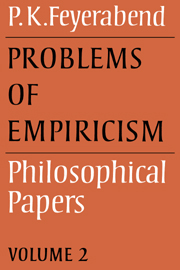Book contents
- Frontmatter
- Contents
- Introduction to volumes 1 and 2
- 1 Historical background
- 2 Classical empiricism
- 3 The structure of science
- 4 Two models of epistemic change
- 5 Philosophy of science versus scientific practice
- 6 Mach, Einstein and the Popperians
- 7 Wittgenstein's Philosophical Investigations
- 8 Consolations for the specialist
- 9 Popper's Objective Knowledge
- 10 The methodology of scientific research programmes
- 11 More clothes from the emperor's bargain basement
- Sources
- Name Index
- Subject Index
3 - The structure of science
Published online by Cambridge University Press: 05 June 2012
- Frontmatter
- Contents
- Introduction to volumes 1 and 2
- 1 Historical background
- 2 Classical empiricism
- 3 The structure of science
- 4 Two models of epistemic change
- 5 Philosophy of science versus scientific practice
- 6 Mach, Einstein and the Popperians
- 7 Wittgenstein's Philosophical Investigations
- 8 Consolations for the specialist
- 9 Popper's Objective Knowledge
- 10 The methodology of scientific research programmes
- 11 More clothes from the emperor's bargain basement
- Sources
- Name Index
- Subject Index
Summary
1. Science, says Professor Nagel, ‘takes its ultimate point of departure from problems suggested by observing things and events encountered in actual experience’ (78); ‘it aims to understand these observable things by discovering some systematic order in them’ i.e. by explaining them (78). It is this ‘desire for explanations which are at once systematic and controlled by factual evidence that generates science’ (4; see also 15). Understanding the structure of science, therefore, means understanding the structure of scientific explanations (15).
The view of explanation set forth by Nagel does not differ in any essential respect from the hypothetico–deductive account. However, a considerable amount of detail is added. In what follows I shall deal with the distinction drawn between experimental laws and theories (ch. 5); the cognitive status of theories (vi); the explanation of established theories (laws) by other theories (ch. 11); and with Nagel's general views concerning the structure of science.
2. Theories are distinguished from experimental laws because they ‘employ terms like “molecule” which ostensibly designate nothing observable’ (80). The distinction does not mean that laws are more highly confirmed than theories, or that theories are ‘entirely speculative’ (80). Nor is it assumed that experimental laws express ‘relations between data … apprehended directly or non-inferentially through various sense organs’ (81; 122). The vagueness of the term ‘observable’ (83; 90); the difficulty of proposing a ‘precise criterion’ distinguishing theories and experimental laws are duly acknowledged.
- Type
- Chapter
- Information
- Problems of EmpiricismPhilosophical Papers, pp. 52 - 64Publisher: Cambridge University PressPrint publication year: 1981

